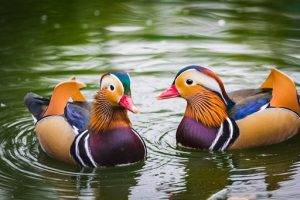When we think of ducks, our minds often conjure images of serene ponds, graceful paddling, and the gentle quacking of these waterfowl. Ducks indeed embody a sense of tranquility in our natural landscapes, but beneath their placid exterior lies a fascinating world of avian biology and behavior.
In this blog, we embark on a journey to explore a question that has intrigued many: Do ducks need to be in pairs? Let’s delve into the intriguing world of duck social dynamics to gain a deeper understanding of these beloved birds.
The Remarkable World of Duck Behavior
Before we delve into whether ducks need to be in pairs, let’s begin by appreciating the unique characteristics of duck behavior and their social tendencies.
Social Nature of Ducks
Ducks are inherently social birds, with their interactions extending beyond mere survival to encompass complex social dynamics. Their social behavior is deeply ingrained in their evolutionary history and is crucial for their well-being in the wild. In addition to the aforementioned activities, such as grooming and feeding, ducks also exhibit fascinating communication patterns within their groups. They employ a diverse repertoire of vocalizations, body postures, and gestures to convey information, maintain group cohesion, and establish dominance hierarchies.
Within duck flocks, individuals often exhibit cooperative behaviors, such as synchronized swimming or foraging, which can enhance their efficiency in finding food and provide protection against predators. Leadership roles may emerge within these flocks, with certain individuals taking on the responsibility of guiding the group to safety or leading them to new foraging grounds.
Social bonds among ducks are not solely based on genetic relatedness. Ducks are capable of forming strong affiliations with non-related individuals, fostering a sense of community within their flocks. These bonds can endure over long periods, with ducks often displaying loyalty and support for their companions in times of need.
The formation and maintenance of social groups also serve important functions during various stages of a duck’s life cycle. For example, during migration, ducks may join larger flocks for improved navigation and protection during the arduous journey. In breeding season, pairs or small groups of ducks establish territories and cooperate in raising offspring, demonstrating cooperative parental care.
Monogamous Pairs
Flock Dynamics
Outside of the breeding season, ducks often gather in flocks, which can vary in size from just a few individuals to hundreds or even thousands. These flocks serve multiple purposes beyond just safety and foraging efficiency.
One crucial aspect is social interaction. Ducks are social birds, and being part of a flock allows them to engage in various social behaviors such as communication, establishing dominance hierarchies, and learning from one another. Younger ducks may learn essential skills like foraging techniques and predator avoidance from more experienced individuals within the flock.
Furthermore, being in a flock provides ducks with opportunities for mating outside of the breeding season. While they may not actively be seeking mates during this time, the social interactions within the flock can facilitate pair bonding and courtship behaviors, which can be essential for future breeding success.
However, despite the benefits of flock living, it’s essential to recognize that ducks do not necessarily need to be in pairs year-round. Unlike some species of birds that form lifelong monogamous pairs, ducks typically form seasonal pair bonds primarily for breeding purposes. Outside of the breeding season, they can thrive within the context of a flock without the need for a specific mate.
The Need for Pairs: Yes or No?
The need for ducks to be in pairs depends on several factors, including their species, life stage, and individual temperament. Let’s explore these factors in more detail:
Species Variation
Different duck species have varying social behaviors. Some species are more prone to forming monogamous pairs, while others are more gregarious and may not exhibit strong pair-bonding tendencies. For example:
- Mallards: Mallards are known for their seasonal monogamous pairs during the breeding season, but they often gather in large flocks outside of that period.
- Wood Ducks: Wood ducks are another species that often forms monogamous pairs during breeding.
- Muscovy Ducks: Muscovy ducks are less likely to form long-term pairs and may exhibit a looser social structure.
Breeding Season vs. Non-Breeding Season
The need for pairs is more pronounced during the breeding season when ducks engage in courtship, mate, and raise their ducklings together. During this time, forming a pair is crucial for reproductive success.
Outside of the breeding season, ducks are more likely to gather in flocks, where they find safety in numbers, share foraging information, and navigate migration together.
Individual Temperament
Duck behavior can also vary from one individual to another. While some ducks may form strong bonds with a single mate, others may be more adaptable and social, interacting with a variety of ducks in their flock.
Related Post:
The Mysterious Potoo Birds: Dangerous Predators or Harmless Night Owls?
How Often Do Birds Poop? Unveiling the Mystery of Avian Excretions
Tackling Tick Troubles: Can Hydrogen Peroxide Kill Ticks on Dogs?
In conclusion, the need for ducks to be in pairs is not a one-size-fits-all scenario. It varies depending on the duck species, the season, and the individual temperament of the duck in question.
While some duck species are known for forming monogamous pairs during the breeding season, ducks are inherently social birds that often gather in flocks for safety and social interaction outside of this period. Their social dynamics add a layer of complexity to their behavior, making them all the more intriguing for bird enthusiasts and observers.
Whether you encounter a pair of ducks gliding peacefully on a pond or a lively flock dabbling in the shallows, there’s no denying the charm and beauty of these waterfowl. In the tranquil ponds and gentle quacks of ducks, there lies a hidden world of nature’s wonders waiting to be explored.




